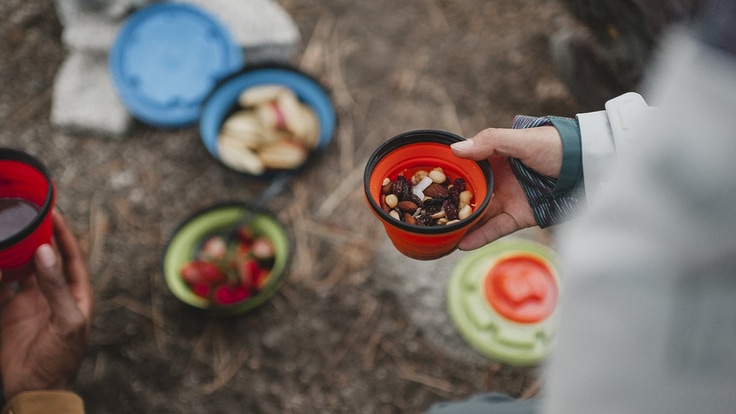Backpackers who take short trips or prefer simple, no-fuss menus require only basic cookware—perhaps as little as a cup and a spork. Campers, larger groups and longer journeys usually require more pieces.
This article gives you an overview of your outdoor cookware options.
Cookset or Individual Pieces?
You can buy a complete cookset or cookware items piece by piece.
Cooksets are collections of pots, pans and lids designed to nest together. Some cooksets include extras such as cups, mugs or plates that nest within the pots.
Individual pieces allow you the freedom to build your set exactly the way you want it. This method may not be ideal if you're looking to save weight for backpacking. However, it's a great way to build versatility into your cookware collection.
Cookware Material Options
Aluminum
- Pros: Lightweight, affordable and a good conductor of heat. Good for simmering foods without scorching.
- Cons: Breaks down slowly when exposed to acidic foods. Dents and scratches easily.
Hard-anodized aluminum
- Pros: This oxidized material resists scratches and abrasion and is long lasting.
- Cons: None.
Stainless steel
- Pros: Tougher, more scratch-resistant than aluminum.
- Cons: Heavier than aluminum, doesn't conduct heat as uniformly (can cause hot spots that scorch food).
Titanium
- Pros: Super lightweight—it's your lightest option without compromised strength. Highly corrosion-resistant, heats up quickly and operates effectively without maximum heat.
- Cons: More expensive than other options. Conducts heat less evenly than stainless steel. Take care not to overheat it.
Cast iron
- Pros: It's tough and ideal for baking or cooking.
- Cons: Very heavy; not for backpacking. Requires proper care.
Nonstick coatings (available on some metal cookware)
- Pros: Make clean up a breeze.
- Cons: Less durable than regular metal surfaces. Most can be scratched by metal utensils.
Plastic
- Pros: Lightweight, cheap, non-abrasive. Perfect for utensils and air-tight food containers.
- Cons: Not as durable or heat-resistant as metal. Some plastics can pick up and retain food flavors/odors.
Cookware Safety Concerns
Aluminum: Some people ask if using aluminum cookware is unhealthful. Based on reports from the National Institutes of Health, the Food and Drug Administration and the London-based Alzheimer's Society, no health risks are associated with the use of aluminum pots, pans or skillets. States the Alzheimer's Society: "There is no conclusive medical or scientific evidence of a link between aluminum and Alzheimer's disease." While not a health concern, cooking leafy greens or cauliflower in aluminum cookware is not recommended since it can impact the taste and appearance.
Nonstick coatings: Cookware coated with food-grade fluoropolymer PTFE can emit toxic fumes if severely overheated. Inhaling these fumes can cause flu-like symptoms in humans, and they have been known to kill pet birds. Use caution when cooking with nonstick-coated cookware (don't use when broiling food, for example) or consider using uncoated options instead.
BPA: Bisphenol A (BPA) is a synthetic compound of potential concern on older cookware. All cookware items sold by REI are BPA-free where food or liquid contact the cookware.
Other Cookware Considerations
Pot size: The largest pot in your cook set should hold approximately 1 pint per backpacker or camper in your party.
Number of pots: This depends on the type of cooking you plan to do and how many campers are in your party. If you plan to cook dehydrated foods for 2 backpackers, then 1 pot is sufficient. More elaborate meals and larger groups require additional pots and pans.
Lids: Lids reduce cooking time, save fuel and reduce splatter. Some cooksets feature a lid for every pot, while others have a single lid that can be used on several different-sized pots. Others can even double as frypans. Certain lids can also serve as plates, which can lighten your load.
Pot lifters or grippers: Make sure you have some way to pick up your pots and pans safely. Most cooksets include 1 gripper for all their pots. Just remember to pack it with you.
The extras: Some cooksets come complete with mugs, utensils, plates, even towels. This is convenient if you're starting from scratch or perhaps redundant if you're not.
Utensils
While car campers can use traditional kitchen utensils, many backpackers seeking to save space and weight have gravitated to the spork. This handy spoon/fork combo offers great versatility for just a fraction of an ounce. Some sporks even include a small knife on the edge of an outside tine.
Adding to the fun, some sporks are known as foons. Those that feature telescoping handles for pot stirring are cleverly referred to as tele-foons.
Don't forget to bring spatulas, measuring spoons and whisks, as needed.
Camp Kitchen Gadgets
Campers don't have to "rough it" with these appliances on hand:
- French press: coffee maker (sized for backpackers, too).
- Dutch oven: slow cooker for meats, stews and more.
- Cooking iron: for hot sandwiches.
- Extension forks: for roasting marshmallows or hot dogs.
- Popcorn popper: always a hit at the campfire.
Also: Bring spice containers, squeeze bottles and clean-up supplies. See the REI Expert Advice Camp Kitchen Checklist for a comprehensive list.
